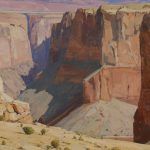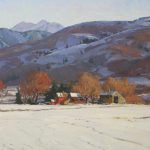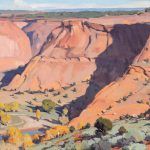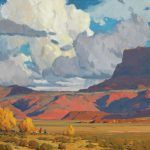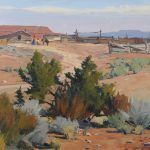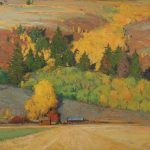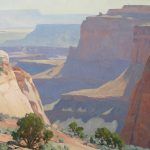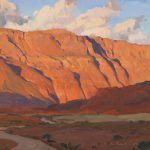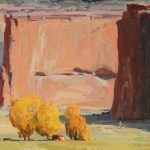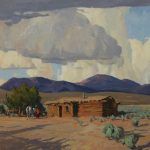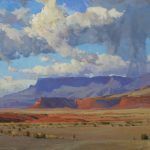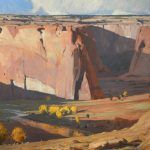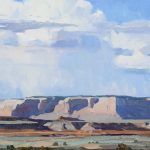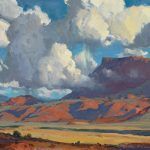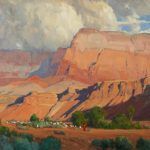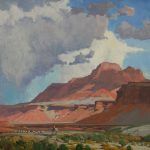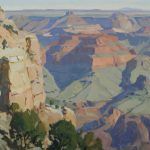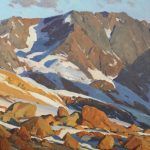G. Russell Case expresses the emotional impact of the western landscape
By Norman Kolpas
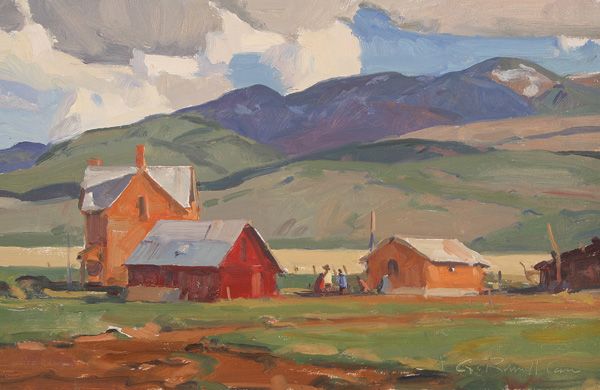
G. Russell Case, Farm Buildings, oil, 10 x 18.
This story was featured in theApril 2017 issue of Southwest Art magazine. Get the Southwest Art April 2017 print issue or digital download now–then subscribe to Southwest Art and never miss another story.
You might not notice them at first, dwarfed by the massive cliffs descending to the narrowing channel cut by the Colorado River. But there, turning a rocky corner on a scrub-flecked dusty slope, are three riders on horseback. Their primary-colored shirts, dark hair, and merest hint of a headband suggest they’re from the nearby Navajo Reservation in northeastern Arizona.
As the size of the human images clearly suggests, the oil entitled DESOLATION PASSAGE is not about the people who appear in it. “I’m not trying to be a figure painter,” says the artist, G. Russell Case. “I’m a landscape painter who sometimes adds figures to create a highlight or some visual interest. Those riders introduce a human element that immediately communicates the grandeur of creation.”
Case’s summation certainly explains a key technical aspect of this particular painting. In a broader sense, however, it also deftly captures his goals as an artist and, even more importantly, as a man of deep faith. At the age of 51, after almost 30 years of seeking meaning in and through his art, Case feels he has finally arrived at a point where his work, his life, and his beliefs have achieved an ideal harmony.
- G. Russell Case, Desolation Passage, oil, 40 x 60.
- G. Russell Case, High Valley Winter, oil, 24 x 36.
- G. Russell Case, In Broad Daylight, oil, 16 x 20.
Case grew up amidst the mountain-ringed splendors of northern Utah’s Cache Valley. His dad, Garry, worked for the U.S. Bureau of Indian Affairs as an illustrator, turning his own college education into a career as a watercolor artist, recording the life of the Navajos. Watching his father at work, young Russell at first took art for granted. “I always drew,” he says, describing days he tagged along with his father as “chasing rabbits and doing paintings.”
That casual attitude changed for Case midway through high school, when an art grad student from Utah State University came to talk to his art class. “I happened to be paying attention that day,” Case laughs, “and what he was saying related to what my dad did and to the art on the walls of our home. So I asked him what I should do if I wanted to be a watercolor painter. He said, ‘Go do a hundred watercolors and then we’ll talk.’”
Back home that night at dinner, Case announced that intention to his father. “And Dad cut me up a bunch of small watercolor pads, and I just started grabbing magazines and calendars and painting the pictures in them.” The point of those repeated exercises soon began to pay off. “By the time you get to a hundred, you’re off and running,” Case says. “It’s like playing the violin. Practice all the time, and then you’re making music.”
Add natural-born talent to that diligent work, and Case’s practice was soon yielding dividends. “My father cut mats and framed some of them and put up a 30-piece show at the local bank. That was when the light came on,” he says. “I realized I could go mow lawns for five bucks each, or sell a little watercolor for 25 bucks.” During his last two years of high school, Case painted “stacks and stacks” of watercolors.
- G. Russell Case, Rest, oil, 20 x 40.
- G. Russell Case, Road to the Corrals, oil, 16 x 20.
- G. Russell Case, September Ranch, oil, 30 x 40.
Not surprisingly, after graduation he went on to study fine art, first at Snow College and then at Utah State. “I came in thinking I was pretty clever painting watercolors and making a living at it,” he says. But, under the rigorous guidance of painting professors Harrison Groutage and Adrian Van Suchtelen, printmaker Moishe Smith, and watercolorist Gaell Lindstrom, who had taught Case’s father, “I got a real awakening to more of the substance of what I was doing,” he says. “They took me to a different level of looking at things and thinking.” In particular, under Lindstrom’s guidance, Case developed a deep appreciation for the clear-eyed, pared-down realism pioneered in the early 20th century by members of the Ashcan School, primarily Robert Henri, as well as the works of Edward Hopper—influences that can be seen in Case’s vast, sparely rendered landscapes.
Groutage, in addition, helped steer him toward a different, more daring career path. Learning that his student had applied to graduate school with the goal of teaching art, he asked him, “Why don’t you paint for a living? If you need to, get a part-time job, and as soon as you can, quit it.” With the support of his wife, Susanne, whom he’d met during his senior year in high school, and with two Utah galleries already carrying his works, Case embarked on a full-time career as a watercolor artist. “I painted so much and always had tons of inventory, selling a few paintings in the galleries and running around every weekend to main-street and park shows,” he says.Within a couple of years of his graduation in 1990, he was accepted into the prestigious Park City Art Festival, “one of the major street shows in the West,” he says. “And I actually sold out, something like 50 or more paintings. That felt really good.” Soon, he also attracted the attention of Dr. Mike Edson and his wife, Karen, who became enthusiastic collectors, supporters, and guides for the blossoming young artist.
- G. Russell Case, Stairway to Heaven, oil, 30 x 40.
- G. Russell Case, Winding Down, oil, 12 x 16.
- G. Russell Case, Autumn Hogan, oil, 16 x 20.
Until the late 1990s, Case continued to work primarily in watercolor, but in 1998, while taking part in the eight-week-long Celebration of Fine Art event in Scottsdale, he observed many of his fellow participants working in oils. The immediacy of the medium appealed to him. “I was so burned out from the lengthy process of watercolors, so I started playing with oils,” he says. “Within a year, I painted everything with oils.” Around the same time, collector Homer Clark—son of the man who had brought more than 100 works by artist Maynard Dixon into the art collection of Brigham Young University—discovered Case and introduced him to that legendary artist’s vision of vast, spare, almost abstracted spaces, a way of seeing the West that also influenced Case’s still-evolving style. “It totally blew my world apart,” he says.
Around that time, Case was offered a contract to be represented exclusively by collector and gallery owner Paul Bingham. “He was the one who took me from the local art scene into national recognition,” Case says. “We worked together for four years, and then we both knew it was time for me to go off on my own.”
As successful as such developments were, however, life began to feel increasingly empty to Case. “My arrogance and pride were driving me, and people were patting me on my back,” he says, his voice tinged with sadness. His work began to feel meaningless, and his personal life suffered. Then, 10 years ago, Case became a born-again Christian, “and my world view changed from me being the center of all this and the art being my idol to everything that I do being to the glory of God.” In turn, he found that his western landscape paintings “slowly turned into praise and worship of the beauty and wonder of this creation”—and that his unique talent was a gift that had been “provided to me to take care of my family.” Almost in a heartbeat, he felt as if his life had turned around completely.
- G. Russell Case, Cabin & Clouds, oil, 16 x 20.
- G. Russell Case, Desert Sentinel, oil, 30 x 40.
- G. Russell Case, Day’s End, Canyon de Chelly, oil, 36 x 48.
Case’s sincere desire to celebrate the world around him through his paintings shines through abundantly in a work like SEPTEMBER RANCH, which depicts a spread the artist has long
admired on the regular drives he makes from northern Utah to Wyoming. “They get autumn early in the high country,” he says, explaining how, during one particular trip when he was headed to the Jackson Hole Fall Arts Festival, he was especially taken by the “direct light and gorgeous pattern” he witnessed. He originally captured the scene directly from life with an 11-by-14-inch plein-air study, later enlarging and simplifying the scene to its spiritual essence in the 30-by-40-inch piece he completed in the studio that adjoins his Brigham City home. The painting vividly represents his goal to “keep maturing in my artistic vocabulary, refining the simplicity of my statements to express the intense emotional impact of my subjects.”
Such deeply expressive landscapes continue to win Case ever more acclaim, not least from his fellow artists, who have bestowed upon him such distinctions as the Artists’ Choice Award at the Coors Western Art Exhibit & Sale in Denver in 2015. “It’s very exciting to realize that you are actually communicating with other people in the way you want,” he says of such accolades. “It’s validating and gives substance and purpose and energy when it comes from your artist friends who speak the same language and know your struggles.”
Then, Case pauses reflectively, and hastens to turn the attention to his wife, their two grown daughters, and their teenaged son. “The whole dynamic of my life has to be credited to my family, who’ve put up with me through this selfish industry as long as they have, making me able to do this work and be healthy in it.”
representation
Astoria Fine Art, Jackson, WY; David Ericson Fine Art, Salt Lake City, UT; Bingham Gallery, Mt. Carmel, UT; Gerald Peters Gallery, Santa Fe, NM; Bischoff’s Gallery, Scottsdale, AZ; Wood River Fine Arts, Ketchum, ID; Maxwell Alexander Gallery, Los Angeles, CA; Summit Fine Art, Billings, MT.
- G. Russell Case, Rain Over Horse Mesa, oil, 20 x 40.
- G. Russell Case, Low Clouds, oil, 16 x 20.
- G. Russell Case, Morning at Vermilion Cliffs, oil, 18 x 30.
- G. Russell Case, Tending Sheep, oil, 30 x 40.
- G. Russell Case, The Grand View, oil, 18 x 24.
This story was featured in theApril 2017 issue of Southwest Art magazine. Get the Southwest Art April 2017 print issue or digital download now–then subscribe to Southwest Art and never miss another story.
MORE RESOURCES FOR ART COLLECTORS & ENTHUSIASTS
• Subscribe to Southwest Art magazine
• Learn how to paint & how to draw with downloads, books, videos & more from North Light Shop
• Sign up for your Southwest Art email newsletter & download a FREE ebook






